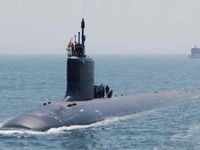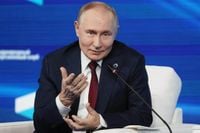In a rapidly changing Indo-Pacific security landscape, the race to develop advanced missile defenses, the collapse of arms control treaties, and the expansion of nuclear alliances are reshaping the region’s strategic balance. This new era is marked by China’s leap in missile defense technology, the unraveling of Cold War-era agreements, and Australia’s controversial AUKUS pact—all unfolding against a backdrop of deepening mistrust, technological rivalry, and mounting fears of a destabilizing arms race.
On October 3, 2025, China stunned the world by fielding a prototype “Golden Dome” missile shield before the United States had even finalized its own design, according to the South China Morning Post. This move signals a dramatic new phase in the arms race between the world’s two largest economies, where the pursuit of security may inadvertently heighten nuclear risk. The People’s Liberation Army, under the leadership of senior engineer Li Xudong of the Nanjing Research Institute of Electronics Technology, has deployed a "distributed early warning detection big data platform". This system is reportedly capable of monitoring up to 1,000 real-time missile launches worldwide by integrating a vast array of space, air, sea, and ground-based sensors. The technology consolidates fragmented data from diverse platforms, distinguishes warheads from decoys, and transmits information across secure, bandwidth-limited military networks using advanced protocols such as Quick UDP Internet Connections (QUIC).
Researchers say this platform gives China unified global situational awareness by consolidating early warning data into a single command layer for the PLA. In contrast, the US Golden Dome—unveiled by President Donald Trump in May 2025 as an integrated missile shield spanning multiple domains—remains mired in architectural uncertainty, with US defense officials citing data-flow management as the program’s most significant hurdle. According to Time in August 2025, the US system envisions a four-layered architecture: space-based sensors and interceptors, Next Generation Interceptors (NGI), Terminal High Altitude Area Defense (THAAD), Aegis systems, and Patriot missiles, all supported by a new missile field in the Midwest to supplement existing Ground-Based Midcourse Defense sites in California and Alaska.
Yet, as Scientific American reported in September 2025, critics argue that the US Golden Dome is plagued by opacity, exorbitant costs, and strategic instability. David Wright, cited in the same report, warns that exempting Golden Dome from “fly before you buy” safeguards risks billions on unproven technology, especially against intercontinental ballistic missiles (ICBMs) that can deploy decoys and chaff. Laura Grego adds that the economics are daunting: ICBMs are far cheaper to build than any missile defense system, and the American Physical Society cautioned in February 2025 that it would take 16,000 interceptors to destroy just 10 ICBMs—while both the US and China each possess around 400 such missiles, according to the US Department of Defense.
China’s own system, while advanced, is still limited to defending key areas and infrastructure, such as Beijing, Shanghai, the Bohai Sea Economic Zone, and the Three Gorges Dam, as noted by Hsiao-Huang Shu of the Institute of National Defense and Security Research. Nonetheless, China’s ability to field a prototype before the US underscores its determination to expand space defenses and project technological parity. Jacob Mezey of the Atlantic Council observes that China’s development of ballistic missile defense strengthens and legitimizes its anti-satellite program and shields its leadership, command-and-control, and nuclear forces from potential US preemptive strikes. This, in turn, complicates adversary planning and deepens crisis stability, but also raises the specter of a launch-on-warning posture that could make nuclear escalation more likely.
These technological leaps are unfolding as the arms control architecture that once stabilized nuclear competition unravels. The Intermediate-Range Nuclear Forces (INF) Treaty, signed in 1987 between the US and the Soviet Union, banned ground-launched ballistic and cruise missiles with ranges of 500 to 5,500 kilometers and led to the destruction of 2,600 missiles, according to the Stockholm International Peace Research Institute. It served as a crucial stabilizing mechanism during the Cold War. However, the US withdrew from the treaty in 2019, citing Russian noncompliance, and in August 2025, Russia declared it would no longer fulfill its commitments, blaming growing threats from the US and Western nations.
This collapse has unleashed a new era of uncertainty. President Trump’s recent announcement that the US would move two nuclear-armed submarines closer to Russia in response to inflammatory statements by former Russian President Dmitry Medvedev highlights the dangers of arms control breakdown. With both the US and Russia now free to develop short-, medium-, and intermediate-range missiles without official restraint, the risks of misunderstandings, arms racing, and nuclear proliferation are sharply increasing—especially in Europe and the Asia-Pacific region.
Technological advances compound the problem. The spread of autonomous delivery systems, hypersonic weapons, and AI-assisted targeting makes modern arms racing faster and more destabilizing. Non-nuclear states, once shielded by treaties, are now reconsidering their nonproliferation commitments, raising fears that more countries may seek nuclear capabilities. As the world’s two largest nuclear powers—estimated to possess 5,328 (US) and 5,580 (Russia) warheads—accelerate modernization, the prospects for cooperative arms control tools have dimmed, making openness, trust, and communication more vital than ever.
Against this tense backdrop, Australia’s escalating $1.6 billion AUKUS commitment for 2025–26, reaffirmed at an August 25, 2025 forum in Canberra, is stirring further controversy. The trilateral pact with the US and UK, which promises nuclear-powered submarines as part of an $8.8 billion multi-year investment, is seen by proponents as vital for deterring regional threats and upholding a “rules-based order” against China’s growing influence. Yet, critics warn that transferring nuclear propulsion technology to Australia, a non-nuclear state, undermines non-proliferation norms and risks fueling an arms race across the Indo-Pacific.
The AUKUS framework, launched in 2021, has evolved to encompass not just submarines but also hypersonics, cyber capabilities, and AI under its so-called Pillar Two, with New Zealand now engaging in these technological areas. However, US and UK shipbuilding programs are facing delays and cost overruns, casting doubt on the viability of the submarine deal. Australia’s $525 million payment to the US in July 2025—amid a Trump administration review of the pact—highlights the fiscal commitment, even as public and parliamentary concerns grow over AUKUS’s escalating costs and its alignment with national interests.
China, for its part, has criticized AUKUS as a relic of Cold War thinking that undermines regional stability and ASEAN centrality. In July 2025, China deepened its defensive posture through trade and military initiatives, while intensifying naval patrols in the South China Sea and Taiwan Strait—a move that has worried ASEAN states concerned about escalating maritime disputes. Diplomatically, Beijing continues to promote its Belt and Road Initiative as a framework for economic interdependence, though questions linger about its transparency and debt implications.
For Southeast Asia, the stakes are high. Nations like Indonesia and Malaysia, guided by the ASEAN Outlook on the Indo-Pacific, strive to preserve neutrality amid mounting pressure to align with great-power blocs. ASEAN’s proactive diplomacy, such as Indonesia’s leadership in maritime security dialogues, offers a possible path to stability—one rooted in dialogue and cooperative security, rather than military escalation. Regional security accords, modeled on the verification procedures of the now-defunct INF Treaty, could help restrain risky deployments and arms modernization in the Asia-Pacific, providing a much-needed brake on the accelerating arms race.
As the Indo-Pacific stands at a crossroads, the choices made now will echo for decades. The region’s future may hinge not on who builds the biggest shield or the fastest missile, but on whether dialogue, diplomacy, and restraint can prevail over suspicion, rivalry, and the relentless march of technology.

